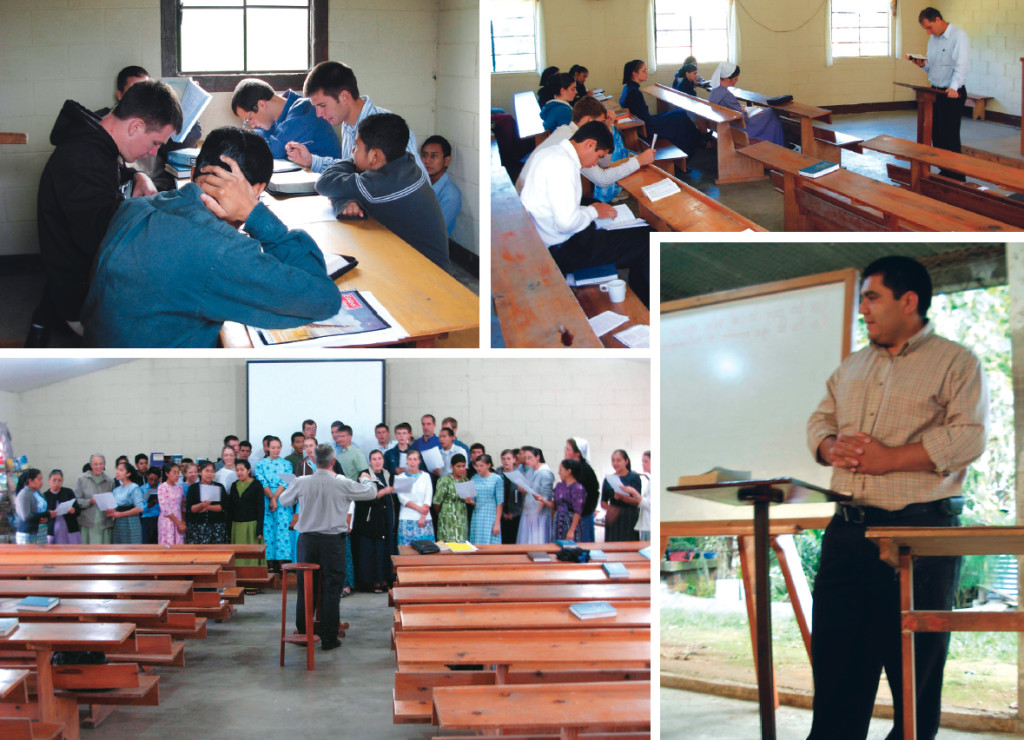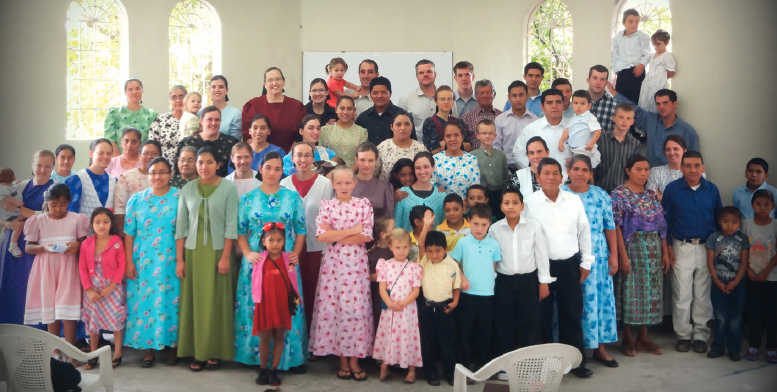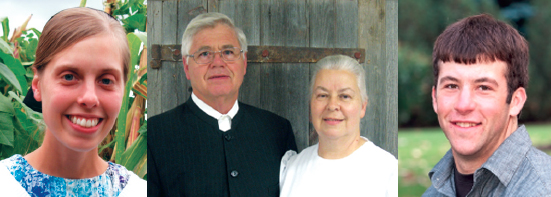
Bible School 2014
Youth Bible School 2014
Paul told Timothy: “Study to shew thyself approved unto God, a workman that needeth not to be ashamed, rightly dividing the word of truth.” Although studying the Bible alone is not enough to “shew thyself approved unto God,” I believe that it is a key part. We need to study God’s Word to be able to discern; to know how to shun the “profane and vain babblings” that Paul mentions in the following verse. That is why many youth were grateful for the opportunity to study the Bible at the first ever Bible School for Youth organized by Mennonite Air Missions.
For quite some time, the MAM institute committee has wanted to try something a little different. Rather than the normal youth institute, where pastors give messages geared toward youth, they wanted to make it more like a school, with classes, teachers, homework, and tests. They wanted a place where the youth could discuss issues, research passages, and share ideas.
This dream became a reality last November. Mennonite youth from all over Guatemala arrived at the “farm” in Sumpango on November 19, with notebooks, pens, and Bibles. During the five days that followed, we youth learned many new things about the Bible, and I believe that many who attended were able to strengthen their relationship with Christ.
A normal day at Bible school started with breakfast at 7:00, after a time of meditation in the dorms. After breakfast was a time of worship in the chapel, with different young men leading singing and sharing a meditation each morning. After morning worship was a fifteen-minute break before the first class.
Beforehand, each student had chosen his classes out of the following options: “Joseph”, by Stephan Gingerich, “Saint John”, by Mark Gingerich, “Proverbs”, by Ross Good, “Music and Choir”, by Mark Gingerich, “A Faith Worth Dying For”, by Cesar Vasquez, and “Dead to Self in Order to Live for Christ”, by Stephan Gingerich. Each student had one study hall during one of the classes that he had not chosen. There were two class periods each morning and two in the afternoon. Each evening at sixthirty was a worship service in which Byron de la Rosa preached a series on “Lessons from the Life of Samson.”
I can’t speak for all of the classes, but the ones I took were very well taught. Brother Mark presented a very interesting summary of Saint John in four days. In that class, we also memorized the first fourteen verses of John 1. In “A Faith Worth Dying For,” Brother César talked about the history of the Christian faith, and we learned how the faith with which God builds His church is a faith that makes disciples, loves enemies, and endures suffering. Every student was required to take “Music and Choir.” Brother Mark made the class interesting with his “DO RE MI” exercises, scales, and singing songs in rounds. On Saturday, we made a recording of some of the songs wehad learned throughout the week, and on Sunday evening, the youth choir sang a number of songs for the audience. Brother Byron’s messages were very well presented and challenging, as he warned us to examine our own lives before judging Samson. All of the students seemed to really enjoy the classes they had chosen, and I think everyone wished they could have been in every class.
I am very grateful for the opportunity I was given to attend the Bible School for Youth this year. I was challenged the most in the “Faith Worth Dying For” class. I have the tendency to put people like Stephen, Peter, and other martyrs on a different level. How can I have that kind of faith if I live in a free country? Every Christian can and must have that same faith. We may not face the same kind of persecution as others have, but we can still know our quality of faith by how we love others, how we love our enemies, and how we serve Christ. It is one thing to say, “Yes, I believe that Jesus is the Son of God.” It is another thing to show that we believe through the way we live.
Seeing forty young people diligently reading, memorizing, and studying all week was encouraging to everyone. After the final tests on Sunday, Byron mentioned that he had looked at the final grades of some of the diplomas, and that he had seen mostly nineties. That shows that the youth who came to the Bible school were serious about studying the Bible. My prayer is that we would continue to study God’s Word diligently, that we would live lives approved unto God, and that we would rightly discern His truth.
~ Ricky Martin
What is in Your Heart?
“And when he had called all the people unto him, he said unto them, Hearken unto me every one of you, and understand: There is nothing from without a man, that entering into him can defile him: but the things which come out of him, those are they that defile the man” (Mark 7:14, 15).
The Old Testament often uses two words to refer to the heart: leb and lebab. If you look up the word “heart” in a Bible dictionary, you will find that it means the totality or the essence of all the things or activities of man. Many times it represents not only his physical part, but also his character, his personality, his will, and his mind.
Understanding this is clearly important, but more important, how is your heart? What is in it?
Mark 7:20-23 states: “That which cometh out of the man, that defileth the man. For from within, out of the heart of men, proceed evil thoughts, adulteries, fornications, murders, thefts, covetousness, wickedness, deceit, lasciviousness, an evil eye, blasphemy, pride, foolishness: All these evil things come from within, and defile the man.”
Brother, I don’t know if you noticed, but thirteen evil things come from the heart of man, and thirteen is the number of rebellion. I ask myself how all these things get into the heart of man. At what time? Did someone put them there?
In Genesis 8:21 we should notice that the intention of the heart of man is evil from his youth. We find that the problem begins at youth. So when does youth begin? We understand that it is the moment of entering adolescence. Then, as we have explained before, the precious little boy begins behaving rebelliously. He used to like to go out with his parents, but now he doesn’t want to have anything to do with them. He begins to pick up bad habits and his character becomes hardened.
When does it happen that children begin to judge their parents and consider themselves superior to them? When they enter into youth stage, we sometimes hear expressions like this: “Oh, Mom, you’re outdated; you’re an old timer; you don’t know anything; you’re obsolete.”
So what can we do about it? The answer is simple. First we need to understand what is really in our heart. Even if we don’t see all the things that Christ mentions in Mark in our heart, there must be something. Bad thoughts? Gossip and envy? Slander, pride, or foolishness?
Well, I don’t know what is in your heart, but God and you do. If you’re not sure, tell it to the Lord, and He will show you. Then give it to Him.
Just as these contaminating things can proceed from the heart, even so we can fill our heart with good things to replace the bad.
“As in water face answereth to face, so the heart of man to man” (Proverbs 27:19). If there is joy in your heart, your countenance will be joyful. If there is peace in your heart, you will be a gentle man. If there is goodness in your heart, you will be a kind man. Today is a good day to search our hearts to find out what is there.
Blessed be God who has a remedy for the needs of our heart: Christ and the Word. By the Word we can lift up holy hands before God. By the Word we can have a pure heart.
~ José Humberto Mux

The Diverse Congregation at El Chal
El Chal
The year was 1974. In an effort to quiet its citizens who were rankled about unfair land distribution, the Guatemalan government offered cheap land to whoever was brave enough to settle the wild, northern third of the country. The Petén of those days could best be described with two words: trees and mud. Three aspiring young men from Chimaltenango staked their claim in El Chal. Domingo Estrada was the middle of three brothers.
The year was 1975. The Sanford Yoder family bounced through the Petén en route from USA to their final destination, Costa Rica. As they passed through a small village with thatch-roofed houses between Flores and Poptún, they threw small packets of tracts out the vehicle windows. How the people ran to snatch them up! The Yoder family prayed that God would provide someone to bring the Light to that hungry town. Even after they arrived in Costa Rica, Brother Sanford continued to pray for that town named El Chal.
The year was 1976. Domingo Estrada, speaking of their move in 1974 says, “For two years I had church in my house. I knew Brother Harold Kauffman and asked him to help us start a church, but he had good reasons and didn’t move quickly. He finally said, ‘Okay, I will send a young man to help you.’ And he sent Juan Ovalle. That’s how the church in El Chal started.”
The first pastor was Guillermo Santos, commissioned to El Chal from San Andrés. The first chapel was built in 1976. Mark and Norma Gingerich moved to El Chal with their family in 1977. Rumors sizzled through the community about the tiny new church. “Did you hear?! At that Mennonite church, the pastor washes all the people’s feet and then makes them drink the water!”
Catalino Segura was ordained deacon in 1979, at the same time his brother Rafael was ordained minister. As guerrilla and army activity intensified, Mark continued to work beside these two brothers. The pressure to help the community with civil patrol was high. The brothers accepted civil patrol responsibility, but refused to carry guns. They took their Bibles instead. Eventually, Catalino moved to Poptún and returned to El Chal only on weekends. Rafael went to La Sorpresa to avoid civil patrol pressure. In 1981, when Harold Kauffman left the country, Mark and Norma moved to mission headquarters to cover the needs there. After most North Americans fled the country, Catalino Segura carried on the leadership in El Chal until 1992.

The new church building was finished in 2007
The church walked through dark days in 1992. Many members chose to leave the church during the time that Catalino Segura was asked to resign from the ministry. What a day of rejoicing when his wife María returned to the Lord and the church in 2007! She is an encouraging example to all of us, an example of joy in the face of trials.
Mark and Norma returned to El Chal in 1992 to lead the church. Times were difficult. The mission property was in a state of disrepair because no one had lived there for a time. The flock was dismembered, discouraged, and traumatized. The Gingerich family stepped in to pick up the pieces. Except for a three year span from 1996-1998, they continued serving there until 2004. Glenn and Grace Martin covered the period when Mark’s family moved to Ontario to accommodate their children’s educational needs.
Stephan and Brenda Gingerich replaced Mark as pastor of the church in 2004. Mark and Norma moved to Guatemala City after Mark was ordained bishop for several churches. Stephan continues to serve in the capacity of pastor at the time of this writing.
In 2006 construction of a new church building began at a new site. The happy church family celebrated the first service there in June 2007.
At present there are thirty-three members in the congregation. At least five nationalities or people groups are represented in that number, presenting a challenge for leadership to meet the needs of a group of such variety. But what a foretaste of Heaven when all those voices and colors blend to praise their Redeemer, from so many “tribes and nations”!
Presently most of the national members stand alone in their families as Christians. The challenge for them to be a light in those dark homes is immense. Pray for them as they live out that Light, and pray for wisdom for those who disciple them.
Another aspect of church life here is that many North Americans come here for their first experience in Guatemala, then continue on to other places of service. Several national young people have done the same; they came for development and then returned to their home areas. The constant staff turnover presents a complex challenge for our congregation. The temptation is to keep newcomers and “soon-goers” at arm’s length to avoid the pain of parting. Stable people would be a tremendous blessing to the local congregation.
Pray for leadership needs. Pray for stamina and faithfulness for our congregation as we fight many of the same battles you do. May all who come behind us find us faithful! May the footprints that we leave lead them to believe . . . and the lives we live inspire them to obey! Oh, may all who come behind us find us faithful!
~ Compiled by Judith Lehman

Staff Changes
Staff Changes
Abigail Martin came to Guatemala the end of October to begin a two year term. She was plunged directly into the work of the El Naranjo clinic beside Aura, a native sister, to learn the pharmacy as quickly as possible before both Yalonda and Melody left less than a month later. Both Abigail and Aura are new to the clinic in El Naranjo, so please pray for each clinic worker over this time. Abigail is part of the Shippensburg Christian Fellowship in Pennsylvania.
David and Erma Martin are filling in for us as house parents at headquarters for six weeks, beginning November 7. They were here for three months last year, and their experience is a real blessing. We thank them for the effort they put into the work.
Ben Brubacher arrived on November 13 from the Woodlawn church in Ontario. He will be serving in El Chal for a two year term.
Yalonda Miller left Guatemala on November 14 after giving more than nine years in service to the Lord, mostly in the Petén region. She worked in the El Naranjo clinic pharmacy and was a blessing to the team there. We wish her the Lord’s blessing as she adjusts to life in the States.
Melody Showalter also left Guatemala the day after Yalonda. She served with MAM for nearly four and a half years, working beside Yalonda in the clinic. Her commitment and dedication have been greatly appreciated, and we greatly thank her for what she has done here.
Download The Entire January/February Newsletter

